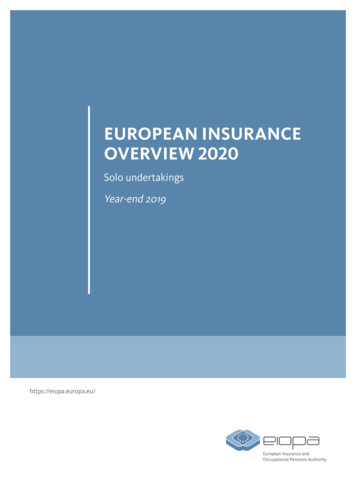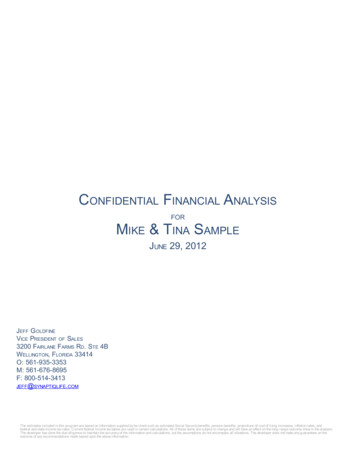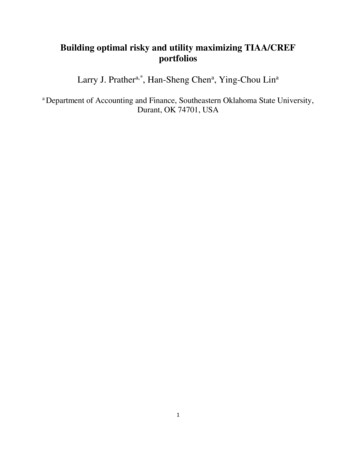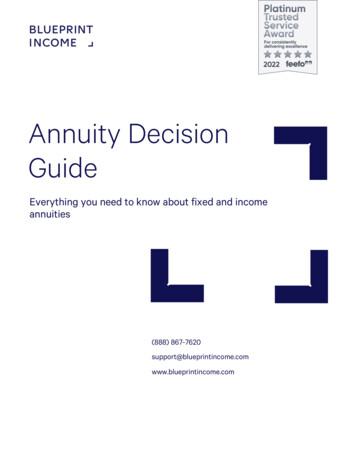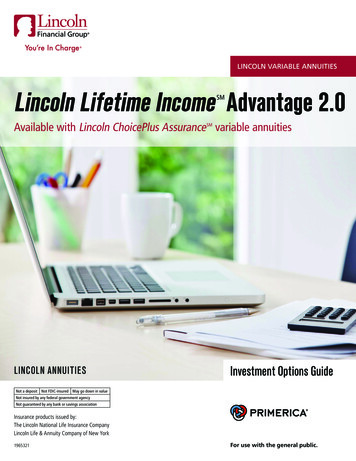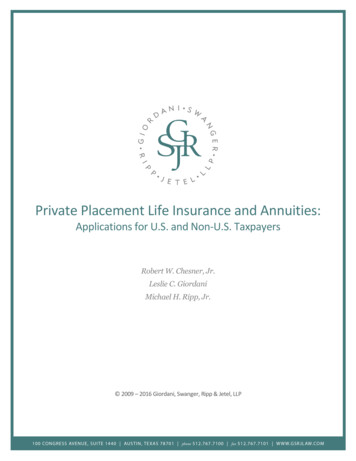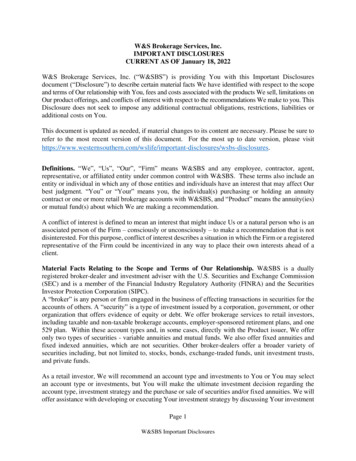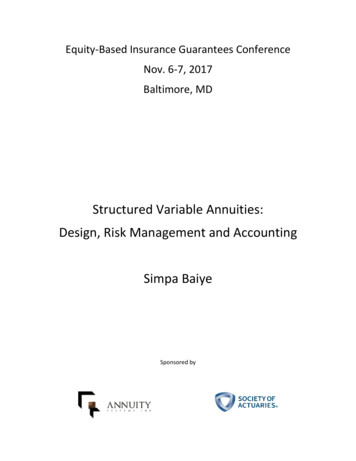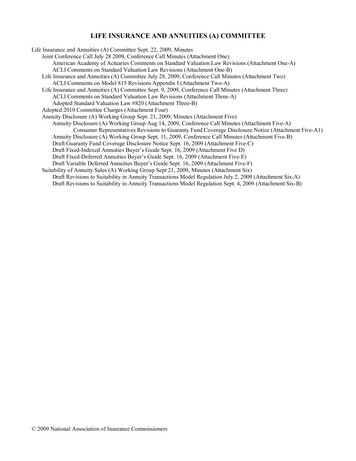
Transcription
LIFE INSURANCE AND ANNUITIES (A) COMMITTEELife Insurance and Annuities (A) Committee Sept. 22, 2009, MinutesJoint Conference Call July 28 2009, Conference Call Minutes (Attachment One)American Academy of Actuaries Comments on Standard Valuation Law Revisions (Attachment One-A)ACLI Comments on Standard Valuation Law Revisions (Attachment One-B)Life Insurance and Annuities (A) Committee July 28, 2009, Conference Call Minutes (Attachment Two)ACLI Comments on Model 815 Revisions Appendix I (Attachment Two-A)Life Insurance and Annuities (A) Committee Sept. 9, 2009, Conference Call Minutes (Attachment Three)ACLI Comments on Standard Valuation Law Revisions (Attachment Three-A)Adopted Standard Valuation Law #820 (Attachment Three-B)Adopted 2010 Committee Charges (Attachment Four)Annuity Disclosure (A) Working Group Sept. 21, 2009, Minutes (Attachment Five)Annuity Disclosure (A) Working Group Aug 14, 2009, Conference Call Minutes (Attachment Five-A)Consumer Representatives Revisions to Guaranty Fund Coverage Disclosure Notice (Attachment Five-A1)Annuity Disclosure (A) Working Group Sept. 11, 2009, Conference Call Minutes (Attachment Five-B)Draft Guaranty Fund Coverage Disclosure Notice Sept. 16, 2009 (Attachment Five-C)Draft Fixed-Indexed Annuities Buyer’s Guide Sept. 16, 2009 (Attachment Five D)Draft Fixed-Deferred Annuities Buyer’s Guide Sept. 16, 2009 (Attachment Five-E)Draft Variable Deferred Annuities Buyer’s Guide Sept. 16, 2009 (Attachment Five-F)Suitability of Annuity Sales (A) Working Group Sept 21, 2009, Minutes (Attachment Six)Draft Revisions to Suitability in Annuity Transactions Model Regulation July 2, 2009 (Attachment Six-A)Draft Revisions to Suitability in Annuity Transactions Model Regulation Sept. 4, 2009 (Attachment Six-B) 2009 National Association of Insurance Commissioners
Draft: 9/29/09Life Insurance and Annuities (A) CommitteeWashington, DCSeptember 22, 2009The Life Insurance and Annuities (A) Committee met in Washington, DC, Sept. 22, 2009. The following Committeemembers participated: Thomas R. Sullivan, Chair (NY); Adam Hamm, Vice Chair (ND); Jim L. Ridling represented byElizabeth Bookwalter (AL); Steve Poizner represented by Perry Kupferman (CA); Gennet Purcell (DC); Kevin McCarty andMary Beth Senkewicz (FL); Susan E. Voss and Jim Mumford (IA); James J. Donelon represented by Ron Musser (LA);Glenn Wilson represented by Blaine Shepherd (MN); Ann Frohman (NE); Scott J. Kipper represented by Kimberly Everett(NV); James J. Wrynn represented by Kermitt Brooks and Gail Keren (NY); and Sean Dilweg and Kim Shaul (WI). Alsoparticipating was: Larry Bruning (KS).1.Adoption of Conference Call MinutesCommissioner McCarty motioned, and Commissioner Hamm seconded, to adopt the July 28 joint conference call minutes(Attachment One) and the July 28 and Sept. 9 conference call minutes (Attachments Two and Three). The motion passedunanimously.2.Adoption of 2010 Committee ChargesJolie Matthews (NAIC) reviewed the Committee’s 2010 proposed charges. She noted that most of the changes from theCommittee’s 2009 adopted charges were technical. She said the 2009 charge related to the Indexed Annuities Working Grouphad been deleted because the Working Group had completed its work. The Committee voted to disband the Working Groupat the Summer National Meeting. Ms. Bookwalter motioned, and Commissioner Voss seconded, to adopt the 2010 charges(Attachment Four). The motion passed unanimously. Connecticut, Iowa, Nebraska, North Dakota and Wisconsin agreed tosponsor the 2010 charges.3.Federal Legislative UpdateMs. Matthews provided a legislative update of federal bills of interest to the Committee. On Sept. 10, Sen. Herb Kohl (DWI), chair of the Senate Special Committee on Aging, along with Sen. Claire McCaskill (D-MO), Sen. Robert Casey (D-PA)and Sen. Kirsten Gillibrand (D-NY), introduced a new version of the Senior Investment Protection Act of 2009, S. 1661.Also, on Sept. 10, Rep. Paul Hodes (D-NH) introduced the House version, H.R. 3551, along with four co-sponsors. Both ofthese bills have been referred to their committees of jurisdiction and no further action has been taken.Much like the previous version, the stated purpose of the bill is to protect older Americans from misleading and fraudulentmarketing practices, with the goal of increasing retirement security. The bill would provide grants to the states to assist in thedetection, prevention and prosecution of deceptive sales practices perpetrated on seniors. To receive funds, a state wouldneed to adopt senior designation and suitability standards. At a minimum, a state would have to adopt the NAIC ModelRegulation on the Use of Senior-Specific Certifications and Professional Designations in the Sale of Life Insurance andAnnuities (#278) to receive grant funds. However, unlike the previous version, the bill is more prescriptive as to the requiredminimum standards a state would have to satisfy regarding suitability in order to be eligible for grant funds. The bill requiresthat the suitability of the annuity products conform to the Financial Industry Regulatory Authority’s (FINRA) Rule 2821.Ms. Matthews noted that H.R. 2733, Fixed Indexed Annuities and Insurance Products Classification Act of 2009, introducedJune 4 by U.S. Reps. Gregory Meeks (D-NY) and Tom Price (R-GA), continues to gain co-sponsors. To date, the bill has 40co-sponsors. The bill would nullify the U.S. Securities and Exchange Commission (SEC) Rule 151A, Indexed Annuities andCertain Other Insurance Contracts, and clarify that indexed annuities are regulated solely at the state level. The bill has beenreferred to the U.S. House Financial Services Committee. On June 25, Sen. Ben Nelson (D-NE) introduced companionlegislation in the U.S. Senate. That bill, S. 1389, has six co-sponsors. Ms. Matthews said NAIC Government Relations staffwill continue to monitor the bill’s progress and will update the Committee should action be taken on either bill.Ms. Matthews noted that, at the Summer National Meeting, the Committee received an update on H.R. 2748, The RetirementSecurity Needs Lifetime Pay Act. That bill was introduced June 8 by U.S. Reps. Earl Pomeroy (D-ND) and Ginny BrownWaite (R-FL). She said that, while no further activity has taken place on the bill, similar legislation has been introduced in theSenate, S. 1297. H.R. 2748 provides tax incentives for workers to annuitize part of their retirement savings. Specifically, thebill amends the Internal Revenue Code to encourage workers to annuitize some of their retirement savings by providing a 2009 National Association of Insurance Commissioners1
50% tax exclusion for up 10,000 of lifetime annuity payments annually. It also excludes from taxes 25% of lifetime incomepayments from individual retirement accounts (IRAs), qualified plans and similar employer-sponsored retirement savingsplans other than defined benefit plans. The bill also excludes the value of longevity insurance from amounts subject torequired minimum distributions (RMDs), and clarifies the taxation of partial annuity payments. The Senate version, S. 1297,The Retirement Security for Life Act of 2009, amends the Internal Revenue Code to allow an exclusion from gross incomefor 50% of the amount otherwise includible in gross income as guaranteed payments from certain annuity or life insurancecontracts. The bill limits the amount of such exclusion to 20,000 in any taxable year. It also provides for an inflationadjustment of the 20,000 limitation beginning in 2011. Ms. Matthews noted Commissioner Voss’ upcoming testimony onbehalf of the NAIC before the House Financial Services Subcommittee on Capital Markets, Insurance, and GovernmentSponsored Enterprises at a hearing titled, “Recent Innovations in Securitization” on the issue of life settlements.4.Consider Adoption of Working Group Reports:a.Annuity Disclosure Working GroupMr. Mumford reported that the Annuity Disclosure Working Group met Sept. 21. During the meeting, the Working Groupadopted its Aug. 14 and Sept. 11 conference call minutes. Mr. Mumford said the Working Group agreed to recommend thatthe Committee send two versions of the Sept. 16 draft guaranty association disclosure template—one version that includeslanguage about the free-look period during which time a contract may be returned, and one version without the free-lookperiod information—to the Receivership and Insolvency (E) Task Force for its consideration. Mr. Mumford explained thatthe memorandum notes that it is the opinion of the Working Group that the Receivership and Insolvency Task Force, in thecontext of revising the Life and Health Insurance Guaranty Association Model Act (#520), is in the best position to decidewhether information on free-look periods could appropriately be included in the guaranty association disclosure and whetheran additional reference to the free-look period would then need to be included in Section 19 of the model act. Mr. Mumfordsaid the Working Group approved distributing for comment revised buyer’s guides on fixed-deferred, fixed-indexed andvariable annuities. He said the Working Group continued its discussion of the annuity illustration issue. The Working Groupagreed to distribute for comment the American Academy of Actuaries’ (AAA) revised draft of the American Council of LifeInsurer’s (ACLI) proposed draft annuity illustration guidelines. Mr. Mumford said the Working Group intends to hold aninterim conference call at the beginning of November to discuss a new draft of proposed annuity illustration guidelines.Wayne Mehlman (ACLI) said that only one version of the guaranty association coverage disclosure template should beforwarded to the Receivership and Insolvency Task Force—the version without the free-look information. Mr. Mehlman saidthe content of the guaranty association coverage disclosure should be limited to the information referenced in Section 19 ofthe model act about guaranty fund association coverage. The inclusion of information regarding the free-look period has todo with the contract and, as such, should be included with in the contract documents. In addition, Mr. Mehlman asserted thatthe inclusion of the free-look period information in the guaranty association coverage disclosure document invited buyers tore-think their purchase based on guaranty association coverage, which would circumvent the prohibition in the model actagainst using the existence of the guaranty association as an inducement to purchase an insurance product covered by theguaranty association. Joni Forsythe (National Organization of Life & Health Insurance Guaranty Associations—NOLHGA)questioned whether the Working Group was free to include additional information not specified in the statute because this isa statutorily prescribed notice. Ms Senkewicz explained that the model act specifically makes reference to the inclusion ofadditional information as directed by the commissioner, so information about the free-look period could properly be included.Birny Birnbaum (Center for Economic Justice—CEJ) explained that the NAIC funded consumer representatives hadsubmitted a draft guaranty association coverage disclosure template that, in his opinion, was more consumer-friendly andeasier to understand than the current draft. Consumer representatives, who analyzed the current draft, placed it at a graduatereading level. Mr. Birnbaum said consumer disclosures are about giving consumers relevant information at the appropriatetime. Mr. Birnbaum explained that the guaranty association coverage disclosure template is intended to impart informationthat might influence a consumer’s decision, which does not violate the advertising prohibition in the model act. For example,the requirement that the disclosure include information indicating where the consumer can research the financial health ofinsurers is intended to give information that might influence the consumer’s decision. He said that including informationabout the free-look period is appropriate, as it helps ensure that the disclosure is meaningful and consumers understand thatthey can change their mind based on the information they receive in the disclosure. Mr. Birnbaum said he accepted theWorking Group’s decision to report two versions of the guaranty association coverage disclosure template to theReceivership and Insolvency Task Force, because there will be an opportunity for him to make these arguments before theTask Force to resolve the issue. Commissioner Hamm motioned, and Director Frohman seconded, to adopt the AnnuityDisclosure Working Group report (Attachment Five). The motion passed unanimously, which included adopting the WorkingGroup’s recommendation to forward two versions of the draft guaranty fund coverage association template to theReceivership and Insolvency Task Force for its consideration. 2009 National Association of Insurance Commissioners2
b.Suitability of Annuity Sales Working GroupMs. Shaul reported that the Suitability of Annuity Sales Working Group met Sept. 21. During its meeting, the WorkingGroup reviewed and discussed a recently distributed subgroup proposal of proposed revisions to the Suitability in AnnuityTransactions Model Regulation (#275). Ms. Shaul said the Working Group voted to replace the Working Group’s July 2exposure draft with the subgroup’s Sept. 4 draft proposal. This draft will be open for additional comments until Oct. 15. TheWorking Group also voted, consistent with its charge, to affirmatively pursue revising the model regulation rather thancontinuing to discuss the issue of developing a model bulletin. Ms. Shaul noted that the Working Group reached this decisionafter extensive discussion and consideration of some of the comments received on the subgroup’s draft proposal. TheWorking Group agreed to ask this Committee for a one-year extension to complete its work on the model regulation. Ms.Shaul said the Working Group anticipates, however, completing its work by year-end 2009. Commissioner Dilweg motioned,and Commissioner Voss seconded, to adopt the Suitability of Annuity Sales Working Group report, which included grantingthe Working Group’s request for a one-year extension to complete its work (Attachment Six). The motioned passedunanimously.5.Life and Health Actuarial Task Force ReportMr. Bruning reported that the Life and Health Actuarial Task Force met Sept. 21. He said the Task Force approvedcontinuing the Task Force’s 2009 charges for 2010 and adding a new charge to review some aspects of the StandardNonforfeiture Law for Individual Deferred Annuities (#805). Mr. Bruning noted that Utah agreed to spearhead this effort.The Task Force discussed the appropriate experience mortality tables and the margins on those mortality tables for theprinciple-based reserving system and for a net premium reserve system. It also discussed several issues related to thedevelopment of a new valuation mortality table for payout annuities. The Task Force heard a presentation by the ACLIregarding an additional net premium reserve methodology for VM-20, the section of the Valuation Manual for life insuranceproducts. Mr. Bruning said the Task Force anticipated receiving a report in mid-October from the ACLI regarding thistesting. Mr. Bruning said the Task Force received reports from its subgroups on various portions of the Valuation Manual.VM-00 was amended and released for comment. Mr. Bruning said the Task Force adopted amendments to ActuarialGuideline XXXIII—Determining CARVM Reserves for Annuity Contracts with Elective Benefits related to guaranteedlifetime income benefits. Director Frohman motioned, and Mr. Shepherd seconded, to adopt the Life and Health ActuarialTask Force report, which included adopting the revisions to Actuarial Guideline XXXIII—Determining CARVM Reservesfor Annuity Contracts with Elective Benefits. The motion passed unanimously.Having no further business, the Life Insurance and Annuities (A) Committee adjourned.W:\Sep09\Cmte\A\09-Amin.doc 2009 National Association of Insurance Commissioners3
Attachment OneLife Insurance and Annuities (A) Committee9/22/09Draft: 8/5/09Joint Life Insurance and Annuities (A) Committee,Solvency Modernization Initiative (EX) Task Forceand Principles-Based Reserving (EX) Working GroupConference CallJuly 28, 2009The Life Insurance and Annuities (A) Committee, the Solvency Modernization Initiative (EX) Task Force and the PrinciplesBased Reserving (EX) Working Group of the Solvency Modernization Initiative (EX) Task Force met via conference callJuly 28, 2009. The following Committee members participated: Kermitt Brooks, Chair (NY); Adam Hamm, Vice Chair(ND); Jim L. Ridling represented by David Parsons (AL); Steve Poizner represented by Sheldon Summers (CA); ThomasSullivan represented by Mark Franklin (CT); Thomas E. Hampton represented by Philip Barlow (DC); Kevin McCartyrepresented by Mary Beth Senkewicz (FL); Susan E. Voss represented by Jim Armstrong (IA); James J. Donelon (LA);Glenn Wilson represented by Jaki Gardner (MN); Ann Frohman (NE); Scott Kipper represented by Annette James (NV); andSean Dilweg (WI). The following Task Force members participated: Alfred W. Gross, Chair (VA); Steve Poizner representedby Sheldon Summers (CA); Thomas R. Sullivan represented by Mark Franklin (CT); Thomas E. Hampton represented byPhilip Barlow (DC); Kevin McCarty represented by Mary Beth Senkewicz (FL); Sandy Praeger represented by LarryBruning (KS); Ann Frohman (NE); Kermitt Brooks represented by Joe Fritsch (NY); Mary Jo Hudson (OH); Joel Ariorepresented by Brad Harker (PA); Sean Dilweg (WI). The following Working Group members participated: Thomas E.Hampton, Chair represented by Philip Barlow (DC); Susan Voss, Vice Chair, represented by Jim Armstrong (IA); JimRidling represented by David Parsons (AL) Linda Hall represented by Katie Campbell (AK); Steve Poizner represented bySheldon Summers (CA); Thomas Sullivan represented by Mark Franklin (CT); Kevin McCarty represented by Al Willis(FL); Sandy Praeger represented by Larry Bruning (KS); Ann Frohman (NE); Kermitt Brooks represented by Lou Felice(NY); Adam Hamm (ND) Mary Jo Hudson (OH); Teresa Miller represented by Rae Taylor (OR); Joel Ario represented byBrad Harker (PA); Alfred Gross (VA). Also participating was Thomas Hampton (DC). Also participating was Bill Carmello(NY).1.Opening CommentsMr. Barlow noted that the purpose of the call was to consider adoption of the revised Standard Valuation Law (#820) by eachof the respective NAIC groups, as exposed by the Principles-Based Reserving (EX) Working Group. He stated that hebelieved it was appropriate that action first be considered by the Working Group, then the Solvency Modernization Initiative(EX) Task Force and then the Life Insurance and Annuities (A) Committee.Commissioner Hampton stated that one of the things the Working Group wanted to do was move the Standard Valuation Lawthrough the NAIC committee process, but the intent is that the proposed law would not be given to state legislatures forconsideration until it is accompanied by an initial draft of the Valuation Manual.2.Overview of Standard Valuation LawMr. Bruning provided an overview of the revised Standard Valuation Law as adopted by the Life and Health Actuarial TaskForce. He highlighted those sections of the law where changes had been made and the overall reasons for the changes. Healso highlighted some of the more significant issues considered in the project. Mr. Bruning discussed how the proposedchanges to the law replace the formulaic approach to deal with the ever-changing, and increasingly complex, products beingintroduced in the marketplace. He noted how, in the past several years, the Life and Health Actuarial Task Force has beenconstantly making changes to address the new and changing products. However, because of the paradigm shift towardprinciple-based reserving, the project has proposed to put certain floors into place and is also only applicable to new businesswritten on or after the effective date of the change.Mr. Carmello asked Mr. Bruning to expand upon the floor minimums. As an example, Mr. Bruning discussed how thevariable annuities line of business has a standard scenario as its floor. He discussed how there will be a deterministic reserveused as a floor for certain life insurance products. Mr. Carmello noted that when you consider floors, it should be an objectivefloor. Mr. Bruning noted that the floors would be detailed in the Valuation Manual, not the Standard Valuation Law.Mr. Carmello noted that he did not believe that complexity of the products was the reason why the Life and Health ActuarialTask Force embarked upon the principle-based reserving project. He stated that it was his opinion that the reason this project 2009 National Association of Insurance Commissioners1
Attachment OneLife Insurance and Annuities (A) Committee9/22/09began was that the mortality rates required under the law for term and universal life were too strong in comparison to theinsurers’ pricing. He noted that this created loopholes that were exploited, and thus the need for new reserve standards.Commissioner Dilweg asked if there was any new guidance from the Internal Revenue Service (IRS) regarding the tax issue.Mr. Bruning responded that the IRS had not yet issued anything definitive regarding principle-based reserving, because theidea of minimum net floors was introduced just more than a year ago.3.Consider Adoption of Standard Valuation LawMr. Bruning made a motion that the Principles-Based Reserving Working Group adopt the revised Standard Valuation Law.The motion was seconded by Director Hudson.Donna Claire (American Academy of Actuaries—AAA) stated her organization’s support for the revised Standard ValuationLaw, as discussed within their comment letter (Attachment One-A).John Bruins (American Council of Life Insurers––ACLI) discussed his organization’s concerns regarding the revisedStandard Valuation Law, as discussed within their comment letter (Attachment One-B). He highlighted his organization’sconcern regarding the potential for future needed changes to the Standard Valuation Law, simply because the work on theValuation Manual was not complete. He also highlighted his organization’s concern regarding uniformity with respect toprinciple-based reserving. He noted that the revised Standard Valuation Law allows regulators too much discretion, whichcould create a lack of uniformity. Mr. Bruning responded that the “commissioner discretion” language was added to allowstate legislatures to delegate to the regulator those situations where the guidance did not specifically address a particularissue. He noted that the current law allows a similar type of discretion in the form of regulations or bulletins. Mr. Bruningstated that he believes the revised law is in a form today that is complete.Mr. Carmello noted that one of the reasons that some support the movement to principle-based reserving is the belief that itwill address all risks. He asked Ms. Claire if she believed that was already captured in the asset adequacy analysisrequirements. Ms. Claire replied that methodology does come up with a similar type of reserve, but that not all companies arerequired to perform cash-flow testing. She added that she did not believe an insurer’s senior management would have a goodenough understanding of asset adequacy and how that correlates to the formulaic reserve. Mr. Carmello noted that principlebased reserving also has exceptions. He noted that the need for reserves to be adequate was already required by assetadequacy, but that the purpose of this project was to lower reserves for some products. Ms. Claire responded that it isanticipated that reserves will decrease for some products, but might increase for others.Mr. Felice noted his concern regarding moving forward with the law without the Valuation Manual being complete. He notedthat he was not clear what the catch-up process would be for incorporating additional changes and was not clear what theNAIC was gaining by adopting the revised law at this time. Mr. Bruning discussed how the Life and Health Actuarial TaskForce wanted to move this off its agenda, as it has a great deal of other work to complete. Commissioner Donelon asked ifanyone could speculate how long it would take to complete the Valuation Manual. Mr. Barlow explained how the ValuationManual was intended be a “living document.” Mr. Bruning noted that for year-end 2009, the NAIC would institute its firstprinciple-based reserving method for variable annuities with guaranteed minimum living death benefits. He discussed howthe actuarial guidance that requires this could be moved into the Valuation Manual today as the first product for the manual— and that additional lines of business could be incorporated at any time. Commissioner Donelon asked about the ACLI’sconcerns. Mr. Bruning noted that the Life and Health Actuarial Task Force was waiting on the ACLI in order to complete thenet minimum floor for life insurance. Commissioner Dilweg suggested that the product be held at the Life Insurance andAnnuities Committee and again noted his concern regarding how the IRS views the related tax issue. Mr. Bruning noted thatcompleting the Valuation Manual is an important issue for the NAIC; however, the issue currently on the table is adoptingthe revised Standard Valuation Law — and delaying a vote on that issue would be a distraction to the project. Mr. Feliceasked what the NAIC would do with the revised law until the manual is complete. Mr. Barlow noted that he thought it wasacceptable for the full NAIC membership to adopt the law, and for it not to be provided to state legislators until the ValuationManual is complete. Mr. Parsons expressed his concern that this might conflict with the NAIC’s new model law process. Mr.Barlow noted that this model already went through that process.Ms. Senkewicz called for a vote on the motion. The motion passed, with Alaska, Arkansas, California, Connecticut, Florida,Iowa, Kansas, Nebraska, North Dakota, Ohio, Oregon, Pennsylvania and Virginia voting for the motion; Alabama and NewYork voted against the motion. 2009 National Association of Insurance Commissioners2
Attachment OneLife Insurance and Annuities (A) Committee9/22/09Ms. Campbell noted that she believes the ACLI comment letter misrepresents the issue relative to the commissioner beingable to opt out of using the Valuation Manual. She noted that this language was only in place to address two items: 1) if aspecific valuation for an issue was not addressed in the Valuation Manual; or 2) if the commissioner believed the practiceused by the insurer was not consistent with the law. She also noted that the Life and Health Actuarial Task Force specificallyasked the ACLI several times if there were any changes needed to the Standard Valuation Law to address the net premiumreserve requirement. She stated that each time this was asked, the ACLI responded that the current form of the law wassufficient and no changes were needed. Mr. Bruins responded that the ACLI has an issue with a last-minute change ofwording in Section 12. Mr. Fritsch noted that it was premature to adopt the law, especially if the IRS releases a tax positionthat changes the view of the issue. Commissioner Gross noted that — although it was clear that all of the details are notknown with respect to timing — he was voting for the revised Standard Valuation Law, because he believes it is importantfor the NAIC to show that it is not dragging its feet on its commitment to modernize regulatory practices. Mr. Carmello askedhow the recent comments from the ACLI would be addressed. Mr. Barlow noted that Mr. Bruning already indicated he didnot believe any changes were needed to address the ACLI’s comments. Commissioner Dilweg noted that he was especiallyconcerned about variable annuities because of the current financial crisis and asked if that would be the first product includedin the Valuation Manual. Mr. Barlow indicated that the variable annuities standard would be effective for year-end 2009regardless of any action taken today, but that this new guidance could be included in the manual. Mr. Bruning added thatterm and universal life with secondary guarantees would be drafted first; these, along with variable annuities, were significantand would represent a good first package to present to state legislatures.Director Hudson made a motion that the Solvency Modernization Initiative Task Force adopt the revised Standard ValuationLaw. The motion was seconded by Ms. Senkewicz. The motion passed, with California, Connecticut, District of Columbia,Florida, Kansas, Nebraska, Ohio and Pennsylvania voting for the motion; New York and Wisconsin voted against the motion.Ms. Senkewicz made a motion that the Life Insurance and Annuities Committee adopt the revised Standard Valuation Law.The motion was seconded by Mr. Armstrong. Acting Superintendent Brooks expressed concern about adopting the revisedStandard Valuation Law at this time because the Valuation Manual is not complete. He noted that the ACLI’s letter expressedthe need for regulators to see all of the “moving parts.” He added that it was more appropriate that the vote considers allrelevant information, including the Valuation Manual. Commissioner Donelon agreed, noting that it would be better to holdthe model at the Life Insurance and Annuities Committee, as opposed to the Executive (EX) Committee/Plenary.Commissioner Dilweg asked about the timing of the Life Insurance and Annuities Committee compared to the ExecutiveCommittee/Plenary and wondered if this issue could be decided at the Fall National Meeting. Todd Sells (NAIC) indicatedthat the Executive Committee/Plenary would need more than five days’ notice to be able to consider the model for adoptionat the Fall National Meeting. Ms. Senkewicz indicated that — provided that the Life Insurance and Annuities Committee wasdiscuss
Draft Fixed-Indexed Annuities Buyer's Guide Sept. 16, 2009 (Attachment Five D) Draft Fixed-Deferred Annuities Buyer's Guide Sept. 16, 2009 (Attachment Five-E) . (AAA) revised draft of the American Council of Life Insurer's (ACLI) proposed draft annuity illustration guidelines. Mr. Mumford said the Working Group intends to hold an
